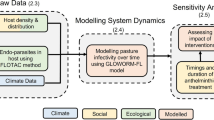Abstract
A cross sectional field study on the distribution of Ixodidae ticks was carried out over two consecutive tick seasons (2012 and 2013) in small ruminants (309 farms) located in mainland and five islands of Greece. A total of 2108 ticks (1199 females, 908 males, and 1 nymph) were collected from sheep and goats. Two species of Rhipicephalus, two of Ixodes, five of Hyalomma, three of Haemaphysalis, and one of Dermacentor were detected. The species with the widest distribution were Rhipicephalus sanguineus s.l. (64.8 %), R. bursa (25.9 %), and Dermacentor marginatus (4.1 %), whereas the least frequently collected species were Ixodes ricinus, I. gibbosus, Haemaphysalis parva, H. sulcata, H. punctata, Hyalomma marginatum, H. excavatum, H. dromedarii, H. rufipes, and H. impeltatum representing together less than 5.3 % of the collections. R. sanguineus s.l. was the predominant species, while D. marginatus and I. gibbosus were restricted to the northeastern Aegean Sea islands. This is the first survey on tick fauna from mainland and islands in Greece.





Similar content being viewed by others
References
Apanaskevich DA, Horak IG (2008) The genus Hyalomma Koch, 1844: V. re-evaluation of the taxonomic rank of taxa comprising the H. (Euhyalomma) marginatum Koch complex of species (Acari : Ixodidae) with redescription of all parasitic stages and notes on biology. Int J Acarol 34(1):13–42
Cringoli G, Otranto D, Testini G, Buono V, Di Giulio G, Traversa D, Lia R, Rinaldi L, Veneziano V, Puccini V (2002) Epidemiology of bovine tick-borne diseases in southern Italy. Vet Res 33(4):421–428
Diakou A, Norte AC, de Carvalho L, Nuncio S, Novakova M, Kautman M, Alivizatos H, Kazantzidis S, Sychra O, Literak I (2016) Ticks and tick-borne pathogens in wild birds in Greece. Parasitol Res 115(5):2011–2016
ELstat (2013) Holdings and number of animals, by animal type, region and department, 2013. in 2013. 20/4/2015 ed. Hellenic Statistical Authority Piraeus, Greece
Estrada-Pena A (2009) Tick-borne pathogens, transmission rates and climate change. Front Biosci 14:2674–2687
Estrada-Peña A, de la Fuente J (2014) The ecology of ticks and epidemiology of tick-borne viral diseases. Antiviral Res 108:104–128
Estrada-Pena A, Bouattour A, Camica J, Walzer AR. (2004) Ticks of domestic animals in the Mediterranean region: a guide to identification of species. University of Zaragosa, Spain; Atalanta Houten, The Netherlands. pp. 1–131.
Estrada-Peña A, Estrada-Sánchez A, Estrada-Sánchez D (2015) Methodological caveats in the environmental modelling and projections of climate niche for ticks, with examples for Ixodes ricinus (Ixodidae). Vet Parasitol 208(1–2):14–25
Gray J, Dantas-Torres F, Estrada-Pena A, Levin M (2013) Systematics and ecology of the brown dog tick, Rhipicephalus sanguineus. Ticks Tick Borne Dis 6(6):872
Guglielmone AA, Robbins RG, Apanaskevich DA, Petney TN, Estrada-Peña A, Horak IG (2014) The hard ticks of the world (Acari: Ixodida: Ixodidae). Springer, Dordrecht, Heidelberg, New York, London, pp. 738.
Hellenic National Meteorological Service. www.hnms.gr.
Heyman P, Cochez C, Hofhuis A, van der Giessen J, Sprong H, Porter SR, Losson B, Saegerman C, Donoso-Mantke O, Niedrig M, Papa A (2010) A clear and present danger: tick-borne diseases in Europe. Expert Rev Anti Infect Ther 8(1):33–50
Jongejan F, Uilenberg G (2004) The global importance of ticks. Parasitology 129(Suppl):S3–S14
Manilla G et al (1998) In: Bologna C (ed) Fauna d’Italia. Acari-Ixodida
Oliver JH Jr (1989) Biology and systematics of ticks (Acari: Ixodida). Annu Rev Ecol Syst 20:397–430
Papa A, Chaligiannis I, Xanthopoulou K, Papaioakim M, Papanastasiou S, Sotiraki S (2011) Ticks parasitizing humans in Greece. Vector Borne Zoonotic Dis 11(5):539–542
Papadopoulos B, Morel PC, Aeschlimann A (1996) Ticks of domestic animals in the Macedonia region of Greece. Vet Parasitol 63:25–40
Papazahariadou MG, Papdopoulos EG, Himonas CA (1995) Seasonal activity of ixodid ticks on goats in northern Greece. Vet Rec 136:585–588
Papazahariadou MG, Saridomichelakis MN, Koutinas AF, Papadopoulos EG, Leontides L (2003) Tick infestation of dogs in Thessaloniki, northern Greece. Med Vet Entomol 17(1):110–113
Pavlidou V, Gerou S, Kahrimanidou M, Papa A (2008) Ticks infesting domestic animals in northern Greece. Exp Appl Acarol 45:195–198
Vagliano C (1985) The continental and island migration route of the southeast Mediterranean: problems and propositions. ICBP Technical Publication No. 5
Walker JB, Keirans JE, Horak IG (2000) The genus Rhipicephalus (Acari, Ixodidae): a guide to the brown ticks of the world. Cambridge University Press, Cambridge
Walker AR, Bouattour A, Camicas JL, Estrada-Peña A, Horak IG, Latif AA, Pegram RG, Preston PM (2014) Ticks of domestic animals in Africa: a guide to identification of species. Bioscience Reports, Edinburgh Scotland
Acknowledgments
The work is part of the FP7 project “ANTIcipating the Global Onset of Novel Epidemics” (Grant agreement no. 278976) supported by the European Commission.
Author information
Authors and Affiliations
Corresponding author
Ethics declarations
Conflict of interest
The authors declare that they have no competing interests.
Rights and permissions
About this article
Cite this article
Chaligiannis, I., Musella, V., Rinaldi, L. et al. Species diversity and spatial distribution of ixodid ticks on small ruminants in Greece. Parasitol Res 115, 4673–4680 (2016). https://doi.org/10.1007/s00436-016-5259-z
Received:
Accepted:
Published:
Issue Date:
DOI: https://doi.org/10.1007/s00436-016-5259-z




